What started as just a small collection of ancient statues has, over the centuries, turned into a complex of the world's most magnificent museums featuring one of the finest collections of art on the planet.
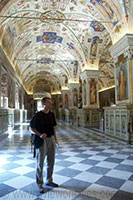
Vatican Museums
The Vatican Museums were founded under the patronage of two 18th century popes - Clement XIV (1769-1774) and Pius VI (1775-1799) - who were among the first to open collections of art to the general public for viewing, therefore promoting culture among the masses.
Appropriately, the first building in the museum complex, the Pio-Clementine Museum, was named after these two pontiffs.
As the decades passed, more popes added to the already impressive collection of diverse artworks owned and displayed by the Vatican.
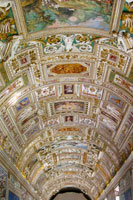
Today, there are 13 museums in about 14 Vatican palaces that are included on tours of the Vatican Museum complex.
The building complex is worth a visit in itself as all rooms and hallways are lavishly decorated with marble and frescoes.

Ceiling of the
Gallery of Maps
Gallery of Maps
Today, there are 13 museums in about 14 Vatican palaces that are included on tours of the Vatican Museum complex.
The building complex is worth a visit in itself as all rooms and hallways are lavishly decorated with marble and frescoes.
The many museums that make up the Vatican complex are quite diverse.
Nonetheless, each is interesting to explore and which you enjoy most will largely depend on your artistic preferences.
Nonetheless, each is interesting to explore and which you enjoy most will largely depend on your artistic preferences.
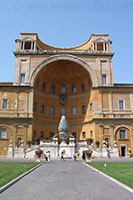
Belvedere Courtyard
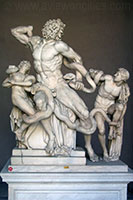
Laocoön
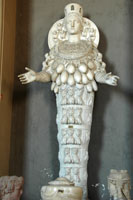
Cybele
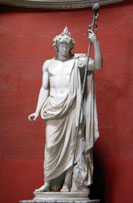
Antinous
The Gregorian Egyptian Museum was founded in 1839 by Pope Gregory XVI, who had a keen interest in Egypt.
Featuring nine rooms, objects d'art in this museum range from stelae and hieroglyphics from around 2500 AD to Roman replicas of Egyptian statues from the 2nd century AD.
Not to miss here is the collection of mummies from around 1000 BC that were found at the Necropolis of Deir el-Bahri in Thebes.
The Gregorian Etruscan Museum was founded by the same Pope. Here you'll find utensils from the pre-Roman era such as a collection of terra-cotta vases. The highlight of the collection is a series of objects found in a necropolis, among them a throne and a carriage.
The Vatican Pinacoteca, one of the newer museums - opened in 1932 - is, technically, a picture gallery. Paintings range in age from the 12th to 19th centuries and include entire rooms devoted to the works of such greats as Raphael and Caravaggio. There's also a unique display of religious icons from the 15th to 19th century.
Founded by Pius XI in 1926, the Ethnological Missionary Museum features objects of a religious nature from four geographical areas - Asia, Oceania, Africa, and America. About 80,000 pieces make up the total collection for this particular museum.
The largest collections of the Vatican Museum are those with ancient Roman and Greek art.
Some of the most famous objects of art can be found in the Pio-Clementine Museum such as the famous Laocoön statue, the Apoxyomenos and the Apollo del Belvedere.
Another interesting museum with
Roman art is the Museo Gregoriano Profano, where you'll find a number of Roman replicas of original Greek statues.
Some of the most famous objects of art can be found in the Pio-Clementine Museum such as the famous Laocoön statue, the Apoxyomenos and the Apollo del Belvedere.
Another interesting museum with
Other museums include the Collection of Modern Religious Art, founded by Pope Paul VI in 1973 and featuring 55 rooms; the Pio Christian Museum (with the Christian and Hebrew Lapidary); Tapestries; Ceramics; Miniature Mosaics; Museo Sacro; Gregorian Profane Museum; and the Vatican Historical Museum, which provides a fascinating look at the long and sometimes turbulent history of the Vatican.
Sistine Chapel and Stanze of Raphael
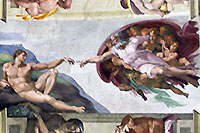
Sistine Chapel
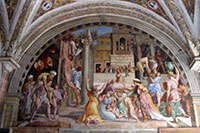
Stanze of Raphael
One of the highlights of the Vatican Museums is the famous Sistine Chapel, where visitors can enjoy not only Michelangelo's magnificent ceiling but also a host of other wonderful works of art, including the The Last Judgment on the altar wall, from the same artist. (Bring binoculars for a better view.)
The ceiling painting, which depicts scenes from the Old Testament, is one of the world's most famous works of art and attracts up to twenty thousand people every day.
In addition, the four rooms known as the Stanze of Raphael, once the residence of Pope Julius II, feature the works of Raphael and others from his school.
Staircase
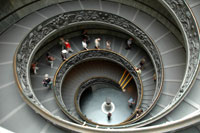
Vatican Staircase
Before exiting the museum you have the chance to admire one of the world's most famous staircases.
Designed in 1932 by Giuseppe Momo, the staircase consists of a double helix, one leading up and one leading down. The beautiful bronze staircase is decorated with papal coats of arms.
Once you've purchased your tickets for admission to the Vatican Museums, you can choose to follow one of four color-coded itineraries that range from 1.5 hours to more than 5 hours.
All itineraries end in the Sistine Chapel.
Even with a five-hour tour, it's impossible to see everything there is to admire, but you'll get a good overview and hit the most well-known highlights of these magnificent museums.
All itineraries end in the Sistine Chapel.
Even with a five-hour tour, it's impossible to see everything there is to admire, but you'll get a good overview and hit the most well-known highlights of these magnificent museums.





No comments:
Post a Comment